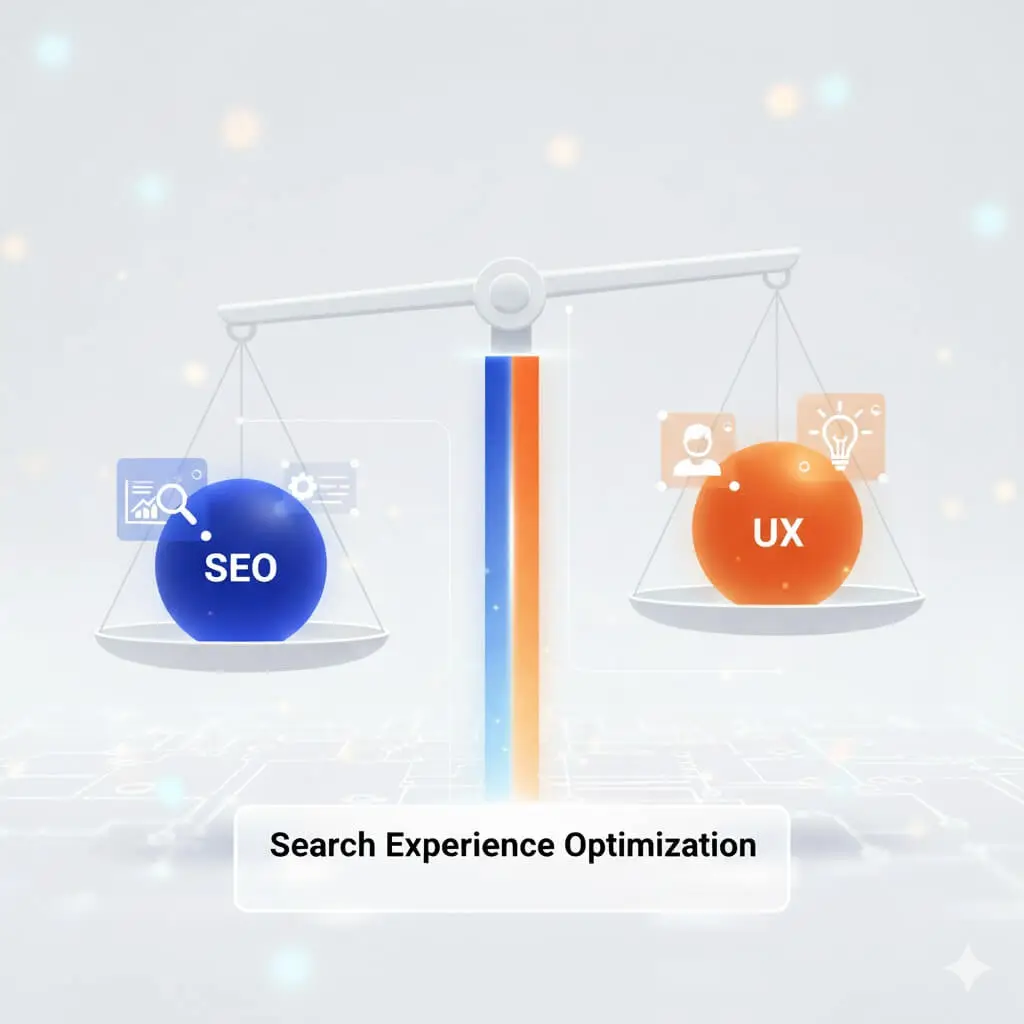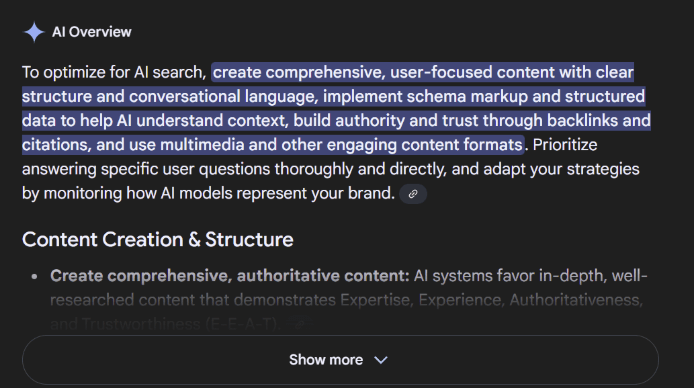Listen to article
In today’s world, having an online presence is key to enhancing credibility, driving sales, and staying competitive.
And while many company leaders are doing their part by adopting SEO best practices, increasing engagement isn’t only about search engine rankings anymore.
Search experience optimization (SXO) is the new wave of SEO, combining traditional SEO with user experience (UX) to deliver greater value to users. With over 85% of consumers in the U.S. shopping online, staying on top of these trends is not only essential but also critical for long-term business growth.
Whether you’re a business owner, a team leader, or someone focused on keeping your company ahead, you should understand the core pillars of SXO, how to future-proof your strategy, and more.
What is Search Experience Optimization (SXO)?
Search experience optimization is an approach that combines SEO and user experience to not only attract organic traffic but also enhance the overall website experience. SXO has naturally emerged as the next step after SEO, leveraging strategies like keyword research, easy navigation, optimized site speed, and high-quality content to turn rankings into conversions and visitors into loyal customers.
SXO vs. SEO
Now that we know what search experience optimization is, let’s take a step back and discuss the foundation of an SXO strategy: traditional SEO.
Search engine optimization, or SEO, is the practice of improving a website’s content, structure, and technical elements to increase visibility in search engines and attract more organic traffic. Traditional SEO techniques include keyword optimization, link building, content creation, site speed improvements, and more.
It’s important to note that there’s nothing outdated about these techniques; SXO doesn’t replace traditional SEO but rather enhances it by improving engagement.
Key differences between SEO and SXO include:
- Purpose: The main goal of SEO is to optimize websites, thereby helping companies rank as high as possible for greater visibility. SXO, on the other hand, prioritizes user experience by ensuring visitors not only find your website but also stay on it.
- Key metrics: A great SEO strategy is measured by rankings, traffic, and click-through rates, while SXO metrics are more user-centric, with engagement and conversion rates used to measure success.
Think of it like this: Have you ever clicked on a website and immediately left? This could be due to site speed, frustrating navigation, or even low-quality content. This demonstrates that having great visibility isn’t enough to increase conversions, and unfortunately, a well-positioned website that doesn’t convert represents lost revenue, missed opportunities, and money left on the table.
In other words, getting visitors to your site is only half the job. Companies that combine search engine optimization and user experience are well positioned to build trust and convert visitors into longtime customers.
The Benefits of SXO
Adopting new strategies can be intimidating. That said, the benefits of SXO are hard to deny, and companies that don’t adopt SXO strategies risk falling behind competitors.
Here are the key benefits that your company can gain:
- Higher conversion rates: A great website experience translates to higher conversions, whether that involves purchasing a product, downloading an e-book, or signing up for a subscription.
- Better reputation: Your website represents your brand. When your storefront is organized, polished, and enjoyable, it sends the right message about your business.
- Search results built to last: Technology is constantly changing. By implementing innovative search engine strategies, you can remain relevant even as user behavior and expectations change. We won’t dive too much into search generative experience optimization yet, as we’ll discuss that in more detail below.
Companies investing in full-service digital marketing services may already be leveraging search engine optimization and user experience to keep users engaged.
However, for those not seeing the results they expected, or those just beginning their SXO journey, Scopic Studios can help guide the way. Contact us today for a tailored SXO strategy.
6 Core Pillars of SXO
By now we know that SXO combines search engine optimization and user experience to achieve higher conversions and long-term growth. The core pillars that make this possible include:
1. SEO Basics: Visibility & Rankings
Remember: SXO doesn’t replace SEO; it enhances it by building on its foundation.
That means that traditional SEO strategies, such as keyword research, high-quality backlinking, and on-page optimization, are still key strategies for improving online visibility.
In fact, it’s the first step to getting people to visit your website. After all, what’s the point of having a great website if no one sees it?
At Scopic Studios, our SEO services help companies increase website traffic and achieve higher conversions, giving them a competitive edge that SXO strengthens even further.
Curious how we helped one of our clients boost organic traffic by 345% and increase organic conversions by 211%? Check out this portfolio entry!
2. Content Quality
The quality of your website’s content is a key component of both SEO and SXO. A strong content strategy ensures that website copy, blog posts, and infographics are keyword-optimized, aligned with search intent, and reflect E-E-A-T principles.
With SXO, the goal isn’t just to put this content in front of website visitors. It’s to make it enjoyable and build trust, thereby increasing the likelihood that users actively interact with your website.
3. Engagement Metrics
As with any strategy, SXO has engagement metrics that help companies and digital marketing agencies better understand whether their strategy is successful.
SXO professionals measure conversion and engagement metrics, including bounce rates, average session duration, and scroll depth, to guide their strategy. For instance, if your website is attracting traffic but demonstrates a high bounce rate, it may be an indicator of slow site speed, irrelevant content, or weak navigation.
4. Site Speed & Performance
Did you know that websites have 50 milliseconds to make a good first impression?
It should come as no surprise, then, that UX is a key pillar of SXO. To accomplish great UX, a website must prioritize visual design, accessibility, and mobile usability to deliver an intuitive, inclusive, and seamless experience for every visitor.
Equally important is site speed, a critical performance metric that directly impacts user satisfaction and SEO. So much so that a recent study states that, “For customer satisfaction, conversion rates, search engine rankings, and overall business effectiveness, a website’s loading and functioning speed is critical.”
5. Technical SEO
Technical SEO optimizes a website’s infrastructure, which in turn prompts search engines to rank your website higher.
SXO experts implement various strategies to enhance a company’s technical SEO, such as creating an SEO-friendly site architecture, submitting the sitemap to search engines, optimizing the website for mobile, and more.
These strategies enhance site speed (remember how we said this was important?) and create a better user experience.
6. Link Authority and Brand Signals
High-authority links signal to both users and search engines that your content is credible, valuable, and worth visiting. Companies with authoritative brand mentions, citations, and backlinks build a semantically and contextually relevant reputation that delivers a wide range of benefits.
Consider these links as “votes of confidence” from other websites. As a result, companies with a comprehensive linking strategy can improve SEO rankings, increase brand awareness, and drive more qualified traffic that leads to higher conversions.

SXO in the Era of Search Generative Experience Optimization
Search generative experience (SGE) uses generative AI to provide users with quick and clear overviews of search topics.
Our recent blog about AI-powered search explains how this works: “Instead of scanning for exact terms, these AI systems: analyze the context of a query to understand what the user really wants, pull relevant details from multiple authoritative pages, and generate summaries that read like a natural, human explanation.”
Many of us have come face-to-face (or screen-to-screen?) with an SGE, which Google has since rebranded as an AI overview. For example, if I type “how to optimize for AI search” into Google, it gives me a quick summary right at the top, along with some links to different sites and companies. Here’s what it looks like:

While this means users don’t necessarily need to click on a website to get an answer, the links included in the AI Overview still give businesses the chance to be discovered and drive traffic.
To remain visible in a constantly evolving landscape, companies must apply search generative experience optimization tactics, such as using long-tail keywords, prioritizing natural language, and implementing structured data.
Future-Proofing with SXO
A good SXO strategy prepares companies for the future. And while it’s impossible to predict with 100% accuracy what the future holds, one thing is clear: AI is changing the future of digital marketing, and companies must be prepared to keep up with new innovations like search generative experience.
To stay ahead of AI-driven changes, here are some strategies every company must consider:
Voice Search and Conversational AI
Voice search and conversational AI are reshaping how users search, moving from short keywords to natural, question-based queries. Your SXO strategy can address this shift by focusing on long-tail, conversational keywords, structured data, and clear answers, ensuring content is accessible to voice assistants and visible in AI-driven search results.
Personalization and Predictive Intent
Personalization and predictive intent, powered by large language models and AI assistants, are transforming search into a more tailored experience. Instead of providing generic results, AI anticipates what users want based on search behavior, preferences, and context. SXO prepares businesses for an AI-first search landscape by ensuring content is relevant and intent-driven.
It seems like every day there’s a new technology or tool. And while we welcome new changes, staying agile is key to remaining visible.
At Scopic Studios, our team stays ahead of trends so you don’t have to. As technologies and expectations evolve, we’ll help you optimize for AI-driven search, adapt your digital strategy, and create experiences that keep your brand visible.
Success Story: How We Enhanced Conversions with SXO
At Scopic Studios, we have a team of SXO professionals that work closely with our clients to increase conversions. One of our favorite projects is our partnership with Shapiro, an organic waste management company dedicated to reducing the environmental impact of food waste.
Our team developed their website, enhancing the UX design to improve the user journey. We also applied all the best SEO and conversion optimization practices so that Shapiro could reach more people and make a greater impact.
As a result, they achieved a 46.9% increase in conversions, demonstrating how search engine optimization and user experience work together to attract, engage, and convert visitors more effectively.
Final Thoughts
Search experience optimization sits at the intersection of SEO and UX, helping companies increase visibility, enhance user experience, and boost conversions.
How to know if you need to improve your SXO strategy?
If your company has strong visibility but low conversions, steady traffic with little engagement, or high rankings paired with short sessions, it may be time to revisit your strategy.
At Scopic Studios, we mix search engine optimization and user experience to help companies attract visitors and keep them on their site.
Contact us today to create a tailored strategy that achieves your business goals.
FAQs about Search Experience Optimization
What is the difference between SEO and SXO?
SEO is the practice of improving a website’s content, structure, and technical elements to increase visibility in search engines. SXO is an approach that combines SEO and user experience to attract organic traffic and enhance the overall website experience.
How to optimize for search generative experience?
Search generative experience optimization tactics include using long-tail keywords, prioritizing natural language, and implementing structured data.
What tools are used for SXO?
SXO relies on a mix of analytics, AI, and entity management tools to enhance visibility, usability, and performance:
- Analytics & Tracking: Google Analytics, Google Search Console, Hotjar
- SEO Suites: SEMrush, Ahrefs
- AI Visibility & GEO Tools: AI Discovery Tool, Peec AI, Raleon, Alli AI
- Entity Management: Google’s Knowledge Panel, Schema.org Validator, OnCrawl, Screaming Frog
What is the role of AI in SXO?
AI plays a key role in SXO by analyzing user intent, personalizing search experiences, and optimizing content to improve visibility, engagement, and conversions.
About Search Experience Optimization Guide
This guide was authored by Baily Ramsey, and reviewed by Assia Belmokhtar, SEO Project Manager at Scopic.
Scopic Studios delivers exceptional and engaging content rooted in our expertise across marketing and creative services. Our team of talented writers and digital experts excel in transforming intricate concepts into captivating narratives tailored for diverse industries. We’re passionate about crafting content that not only resonates but also drives value across all digital platforms.




























































































































































































































































